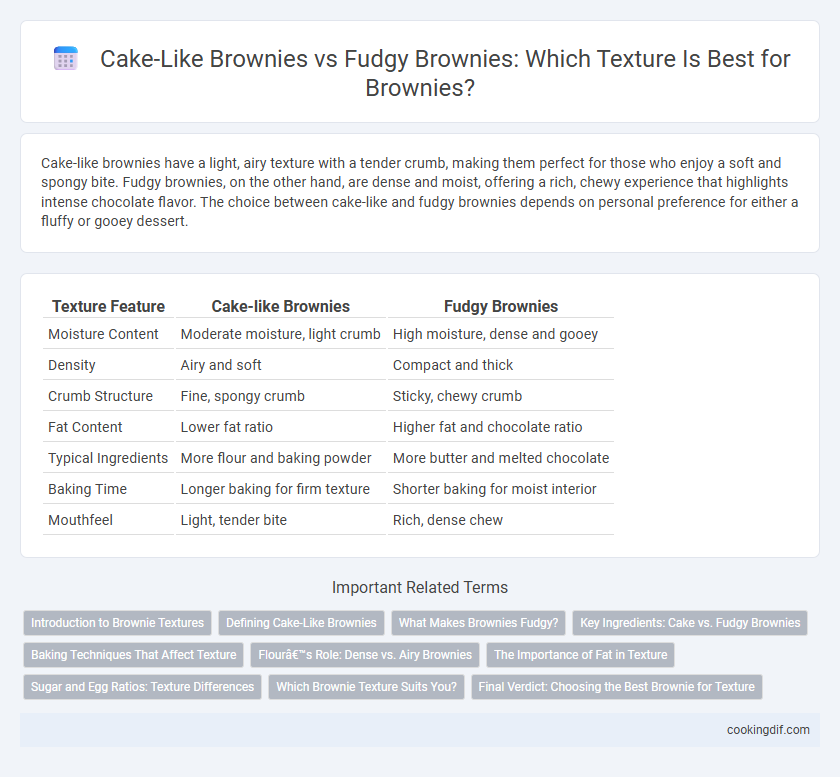Cake-like brownies have a light, airy texture with a tender crumb, making them perfect for those who enjoy a soft and spongy bite. Fudgy brownies, on the other hand, are dense and moist, offering a rich, chewy experience that highlights intense chocolate flavor. The choice between cake-like and fudgy brownies depends on personal preference for either a fluffy or gooey dessert.
Table of Comparison
| Texture Feature | Cake-like Brownies | Fudgy Brownies |
|---|---|---|
| Moisture Content | Moderate moisture, light crumb | High moisture, dense and gooey |
| Density | Airy and soft | Compact and thick |
| Crumb Structure | Fine, spongy crumb | Sticky, chewy crumb |
| Fat Content | Lower fat ratio | Higher fat and chocolate ratio |
| Typical Ingredients | More flour and baking powder | More butter and melted chocolate |
| Baking Time | Longer baking for firm texture | Shorter baking for moist interior |
| Mouthfeel | Light, tender bite | Rich, dense chew |
Introduction to Brownie Textures
Cake-like brownies have a light, airy crumb with a slightly crispy crust, achieved by incorporating more flour and leavening agents such as baking powder. Fudgy brownies feature a dense, moist interior with a glossy, crackly top, emphasizing higher fat content from butter or oil and minimal flour. Understanding these texture differences helps bakers select ingredients and techniques to create the desired brownie experience.
Defining Cake-Like Brownies
Cake-like brownies feature a lighter, airy texture achieved by incorporating more flour and baking powder, resulting in a crumb that resembles traditional cake. This variety contains less fat and sugar compared to fudgy brownies, contributing to their tender and slightly dry consistency. These brownies appeal to those who prefer a soft, spongy bite rather than a dense and chewy one.
What Makes Brownies Fudgy?
The key factor that makes brownies fudgy is their higher fat-to-flour ratio, often achieved by using more butter and melted chocolate rather than cocoa powder. Fudgy brownies have less flour and sugar compared to cake-like brownies, which results in a dense, moist texture instead of a light, airy crumb. The use of minimal leavening agents, like baking powder or baking soda, and careful baking time also contributes to the rich, gooey consistency characteristic of fudgy brownies.
Key Ingredients: Cake vs. Fudgy Brownies
Cake-like brownies contain higher amounts of flour and baking powder, creating a lighter, airy texture with a crumbly bite. Fudgy brownies rely on more butter and chocolate, with less flour, producing a dense, moist interior that melts in the mouth. Balancing sugar and eggs further influences the softness and chewiness, differentiating cake-like brownies from their fudgier counterparts.
Baking Techniques That Affect Texture
Adjusting the ratio of flour to fat significantly influences brownie texture; higher flour content yields cake-like brownies with a light, airy crumb, while increased butter or chocolate creates dense, fudgy brownies. Incorporating baking powder or baking soda introduces leavening, promoting rise and a softer, cakey interior. Mixing methods also impact texture; beating eggs and sugar longer incorporates more air for fluffiness, whereas minimal mixing preserves a dense, fudgy consistency.
Flour’s Role: Dense vs. Airy Brownies
Flour content directly impacts the texture of brownies, with higher flour amounts producing dense, cake-like brownies and lower amounts resulting in fudgy, moist brownies. Cake-like brownies incorporate more flour and baking powder to create a lighter, airy crumb structure, while fudgy brownies rely on minimal flour and higher fat content to maintain a chewy, moist interior. Understanding flour's role allows bakers to control brownie texture, customizing between soft and fudgy or firm and cakey.
The Importance of Fat in Texture
The importance of fat in texture is crucial when differentiating cake-like brownies from fudgy brownies. Cake-like brownies contain less fat and more flour, resulting in a lighter, crumbly texture, while fudgy brownies rely on higher fat content, especially butter or oil, to create a dense, moist, and rich consistency. The type and amount of fat directly influence moisture retention and tenderness, defining the brownie's characteristic mouthfeel.
Sugar and Egg Ratios: Texture Differences
Cake-like brownies typically contain a higher egg-to-flour ratio and less sugar, resulting in a lighter, airier texture with a tender crumb. Fudgy brownies feature increased sugar and fat content alongside fewer eggs, producing a dense, moist interior with a rich, chewy bite. Adjusting the sugar and egg ratios directly influences moisture retention and crumb structure, creating distinct texture profiles between cake-like and fudgy brownies.
Which Brownie Texture Suits You?
Cake-like brownies feature a light, airy structure with a tender crumb, ideal for those who prefer a softer, less dense bite. Fudgy brownies offer a rich, dense texture with intense chocolate flavor, perfect for fans of gooey, decadent treats. Choosing between cake-like and fudgy brownies depends on your preference for either a fluffy or moist and chewy dessert experience.
Final Verdict: Choosing the Best Brownie for Texture
Cake-like brownies offer a light, airy texture with a crisp crust and a tender crumb, ideal for those who prefer a moist yet cakey bite. Fudgy brownies deliver a dense, rich, and gooey consistency with high cocoa and butter content, perfect for chocolate lovers seeking intense flavor and a chewy experience. Selecting the best brownie texture depends on personal preference: cake-like for softness and structure, fudgy for decadence and moisture.
Cake-like brownies vs fudgy brownies for texture Infographic

 cookingdif.com
cookingdif.com